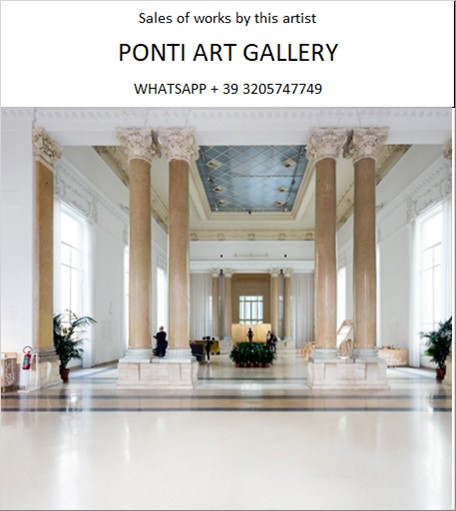Ponti Art Gallery is interested in buying and selling works
of art by this artist.

Philip Evergood Biography
Philip Evergood, born Philip Howard Francis Dixon Blashki on October 26, 1901, in New York City, was an American painter, etcher, lithographer, sculptor, illustrator, and writer. His work, which spanned several decades, was deeply rooted in social realism and often carried strong political and humanist messages. Evergood's art was a reflection of his passionate advocacy for civil rights and his concern for the daily lives of working-class people.
Evergood's early life was marked by a rich cultural heritage and a diverse set of influences. His father, Miles Evergood Blashki, was an Australian artist of Polish Jewish descent, and his mother, Flora Jane Perry, was the well-educated, cultured daughter of a wealthy London merchant. The family moved to London in 1909, where Evergood was educated at the progressive Ethical Culture School and later at Eton College. His mother's family financed his education, which included a stint at Cambridge University, though he left early to pursue his artistic studies.
Evergood's formal art education began at the Slade School of Fine Art in London, where he studied under Henry Tonks. He then moved to New York City to study at the Art Students League with George Luks, a member of the Ashcan School known for depicting scenes of urban life. Evergood's time at the Art Students League was followed by further studies at the Académie Julian in Paris, where he was taught by André Lhote and Jean-Paul Laurens.
The 1930s were a period of deep personal involvement in liberal and radical causes for Evergood. He became president of the Artists Union and was active in the American Artists' Congress. His experiences during the Great Depression led him to turn from biblical subjects to social criticism, and he was also active in organizations devoted to the civil rights of artists. Evergood's art from this period reflects his devotion to egalitarian ideals, and his early paintings are statements of sympathy for those who struggle against oppression.
Evergood's work was characterized by its emotional intensity and its blend of reality and fantasy. He was influenced by the Spanish artist El Greco, and his social realist works often featured exaggeratedly grotesque figures and vibrant, emotive color palettes. His paintings were not only a reflection of the world around him but also a commentary on the human condition, often addressing themes such as political oppression, racial discrimination, and the coarse life among the urban poor.
Despite his strong political views, Evergood's work also contained elements of humor, fantasy, and personal symbolism. He was known for his sophisticated yet deliberately awkward style, which was both gritty and playful. Evergood's art was too raw to be fashionable or as commercially successful as some of his contemporaries, but it was deeply humanist and always aimed at revealing the truth.
Throughout his career, Evergood remained committed to his vision, even as he explored different styles and themes. His later work took on a more surreal and religious bent, though he always maintained the bold, expressive lines and social themes that had defined his earlier work. In the 1940s, Evergood received patronage from Joseph Hirshhorn, which allowed him to focus solely on making art.
Evergood's work is in the collections of major museums in America and abroad, including The Metropolitan Museum of Art, the Whitney Museum of American Art, the Hirshhorn Museum and Sculpture Garden, London’s Tate Gallery, and the Vatican Museum. He was a full member of the Art Students League of New York and the National Institute of Arts and Letters.
Philip Evergood passed away in 1973 in Bridgewater, Connecticut. His legacy as an artist and social commentator continues to be celebrated, and his work remains a powerful testament to his belief in art as a vehicle for social change and human empathy.
Philip Evergood Quotes and
Sales of Works
Ponti Art Gallery selects and deals with paintings by the
artist. Upon request, we provide free estimates and
evaluations, communicate prices, quotations, and current
market values.
If you are interested in BUYING or SELLING works by the
artist, contact us immediately.
If you wish to sell or receive an evaluation of the
works:
Send us a frontal photo of the painting, one of the back,
and one of the signature. Also, indicate the dimensions of
the work. Inform us about the purchase origin of the work
and any kind of available documentation (purchase
receipts, certificates of authenticity, publications). One
of our operators will respond to you on the same day. We
guarantee maximum confidentiality and extreme
professionalism.
If you wish to purchase works by the painter: Contact us
and let us know your request. We will inform you about the
available works. We also offer the possibility to
subscribe to our NEWSLETTER, through which you will be
informed at the beginning of each month about the latest
acquisitions of the art gallery.
You can send us pictures of the work:
